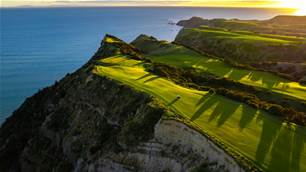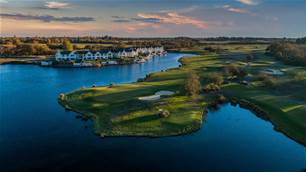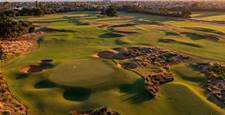The Royal Hobart Golf Club has come a long way since its humble, and quite unusual, beginnings in 1896.
Located at Sandy Bay, not far from where the renowned Wrest Point casino stands today, the club’s original course was known as Newlands and was an incredible par-89, which included a par-7, four par-6s, six par-5s and seven par-4s.
A move to the eastern shore of the Derwent River followed in 1915 and the royal charter was attached to the club a decade later. But Hobart’s expansion forced the club to move again and in 1956 its present sand-based site of 175 acres at Seven Mile Beach – about 20 minutes’ drive east of the city centre – was chosen.
The overwhelming choice to design the new course was Vern Morcom, whose experience as course superintendent at Kingston Heath for nearly 40 years was renowned. In the late 1950s his reputation as one of the country’s foremost course architects was also widely known and coincided with him overseeing more than 15 projects spread throughout South Australia, Victoria and Tasmania.
Morcom was in poor health during the construction of Royal Hobart, which officially opened for play in 1963 and, in this writer’s opinion, is Morcom’s last course creation of great note. Morcom scaled back his design work after 1963 and then retired from Kingston Heath four years later, aged 67.
It took the best golfer of the 20th century to prevail when Royal Hobart became the first, and unfortunately last, Tasmanian course to host the Australian Open some eight years after opening. Jack Nicklaus was never headed after opening rounds of 68-65 and he finished eight shots clear of our local hope Bruce Crampton.
In the decades that followed Royal Hobart’s Open there was seemingly an overriding philosophy at the club to establish a reputation of being a tough golfing test. Fairways were narrowed, bunkers added and all kinds of species of tree were allowed to grow unchecked and into the lines of play.
By the time I played my first round there, some 25 years after Nicklaus’ win, it was mission accomplished. It was tough.

Royal Hobart was one of the first courses I visited with a view to writing about the experience after starting at Golf Australia magazine in 1996. In writing this story, I referred back to my notepad from that trip (yes, I am a hoarder of notebooks) and most of the comments referenced how straight you needed to be from the tee and how being slightly out of position, even on the fairway, could have you blocked out by a tree for your next shot.
By embarking on a journey of making the course difficult with the view that all good courses are tough, Royal Hobart was destined to inflict misery (and a lot of lost balls and ricocheting shots off tree branches) on the less than perfect ball-striker.
This was a quantum leap from Morcom’s original design intentions, who knew the strategic benefit of creating holes that offered a minimum of two playing lines. He knew how to ask questions of the player as they stood on the tee: “What shot, to what side of the fairway, are you going to play here?”
No matter whether it was a short, sharp dogleg par-4 or a reachable par-5 with trouble lining the shortest route, Morcom’s designs – for the most part – ensure there is more than one way to get your ball in the hole.

By the mid- to late-90s, the only significant strategic question being asked was “how good are you at hitting this drive in the absolute middle of the fairway?”
From that first visit to subsequent return trips over the next 20-odd years, that “hard is good” philosophy remained the status quo, just like the presentation of the course.
Just as it was for that first visit in 1996, Royal Hobart continues to shine with beautifully presented playing surfaces. If the national ranking of golf courses was like a beauty pageant, Royal Hobart would have cemented its place among the elite a long time ago.
"We want to really draw on that historical ecology and look to preserve things like the viminalis white gums, the yellow gums and native shrubs that grow in this coastal heathland." – Royal Hobart General Manager, John Mendel.
But such rankings, like Golf Australia’s Top-100 Courses published earlier this year, take a far more discerning look at courses with course design being a primary focus.
Even Royal Hobart’s superior conditioning was not enough to save it from toppling out of the Top-100 ranking in 2014 and staying there until 2018 when it crept back in at No.98.
The previous four years, however, have seen the course climb further. In 2020, it reached No.90 and, earlier this year, it shot up to No.71 – its highest ranking ever in this publication.

It is no coincidence that Royal Hobart’s ongoing climb in the rankings comes as the club embarks on the implementation of a course masterplan carried out by acclaimed designer Richard Chamberlain, which he completed in 2018.
While a 1997 masterplan commissioned by the club was designed to make the course longer and harder, Chamberlain’s take will introduce more strategic elements and, ultimately, offer a more enjoyable round of golf.
The process actually began before Chamberlain arrived on site with the club introducing a tree clearing program that saw 300 blackwood trees removed from the playing corridors, while 400 large radiata pines were also removed from across the course.

This had a two-pronged effect of opening up the playing lines, with fairways able to be cut wider, and improving the overall health of the playing surface grasses, which were out of shade and not having to compete so hard for water from the soil.
“There’s still some really heavy wooded areas and a lot we can still take out,” Course Superintendent Shaun Bowden said. “But what’s been done so far has really been beneficial to a lot of holes on the course.
“The 12th and 15th have improved immensely with the removal of non-native species, planted really close to the fairways, that cast a lot of shade and had tree roots spread into the fairways.”
Royal Hobart’s ongoing vegetation management program will, ultimately, see the layout embrace more of its ecological roots.
“Here on the south-eastern side of Tasmania we’ve got a very unique mix of native species and we think that for the visitor and members alike, we can provide an experience that is authentic to the natural site,” Royal Hobart General Manager John Mendel said.
“We want to really draw on that historical ecology and look to preserve things like the viminalis white gums, the yellow gums and native shrubs that grow in this coastal heathland. The native grasses are also going to be a feature of that.
“We’re moving away from that 1950s, 60s, 70s parkland course model, and more towards a course that people can visit and recognise it for being unique and natural.”
"I was never a fan of Royal Hobart. I played a few rounds there about 10 years ago and left the driver in the bag for both rounds. Too tight, too penal and too one-dimensional. But I played there six months ago and was blown away by how much the course had improved simply by getting rid of a whole lot of trees and widening the fairway cutting lines." – Top-100 ranking judge, Joe Thomas.
The first construction phase of Chamberlain’s masterplan began in February 2020 with the 7th hole being replaced.
There were safety issues between the 6th and 7th holes and the creation of a new hole seemed like the obvious place to start. Chamberlain slashed the length of the hole and has created an absolute gem – a risk-reward, short driveable par-4, that was lacking from the original layout. It’s a ripping hole which tempts from the moment you walk on the tee and feel the hint of breeze at your back. The green complex has subtle slopes, while the surrounds are more dramatic and can easily repel your ball away from the putting surface. Once you have the putter in your hand, the job isn’t done as this is one of the more difficult to read greens on the course.
The creation of the new 7th hole also led to the repositioning of the tee on the par-3 8th hole and has produced a better, more interesting, angle into the green.
“The construction works also included improvements to our practice facilities, with a new chipping green and new laser-levelled practice tee. That’s all now fully-grown in and its looking great,” Mendel said.

“The next phase of works is going to be dependent on when we can realise some money from a real estate sale we’ve got pending. The next thing we’ll do is go into the detailed design phase and we expect that will happen sometime this year.”
In the meantime, Morcom’s design traits remain embedded within the par-73 layout and have been enhanced by the work that has been carried out so far. His dogleg holes – like the sharp-turning left 336-metre 2nd, and the equally bent right 337-metre 5th – have been elevated in stature by the clearing of trees from the edges of the playing corridors. Any number of clubs and shots can now be played from the tees on both holes in pursuit of that elusive par or birdie. Interestingly, both holes are short by modern standards, yet they are index six and eight, respectively, on the scorecard.
Royal Hobart has some wonderful par-3s with the 127-metre par-3 11th being the shortest but one of the most hazardous, particularly in the wind. In still conditions, little more than a short iron is required but when the prevailing breeze gets up a longer club must be used to find the relatively small putting surface, which is ringed by six bunkers.
The fescue fairways combined with its smooth-rolling predominantly Penncross bentgrass greens – although there are trials being conducted on other bentgrasses, including the highly-acclaimed Pure Distinction – are as healthy as I have seen them, and enhance the current design.
I came away from Royal Hobart confident that in January 2024, when the next Top-100 Courses ranking is released, it will have climbed higher again, which is a view shared by some of our ranking judges.
“I was pleasantly surprised at how good Royal Hobart was. It was in great condition and there is a lot of interesting movement in the fairways,” Top-100 judge Brian Walshe said. “Best of all they are addressing tree encroachment and have started to open the course up and get a bit of width into the fairways.”
Ranking judge Joe Thomas added: “I was never a fan of Royal Hobart. I played a few rounds there about 10 years ago and left the driver in the bag for both rounds. Too tight, too penal and too one-dimensional.
“But I played there six months ago and was blown away by how much the course had improved simply by getting rid of a whole lot of trees and widening the fairway cutting lines. I’m actually really excited to go back and see what further enhancements they make to the design.”
This long-time visitor is excited too Joe.
 FACT FILE
FACT FILE
LOCATION: Regal Court, Seven Mile Beach, Hobart, Tasmania.
CONTACT: (03) 6248 6161.
WEBSITE: www.rhgc.com.au
DESIGNERS: Vern Morcom (1963); Richard Chamberlain (2018 & ongoing).
PLAYING SURFACES: Fescue (tees and fairways), Penncross bentgrass (greens).
COURSE SUPERINTENDENT: Shaun Bowden.
PGA PROFESSIONALS: Matthew Docking, Scott Laycock and Courtney Docking.
GREEN FEES: $80 (18 holes, members from other clubs); $110 (visitors).
MEMBERSHIP: Membership is available across a range of categories including seven- and five-days, intermediate, distant country and junior memberships. Check the club’s website for full details.
ACCOLADES: Host of 1971 Australian Open as well as several national amateur events. Ranked No.71 in Golf Australia magazine’s Top-100 Courses for 2022.
Related Articles

Review: Omaha Beach Golf Club

Course Review: Cape Kidnappers













